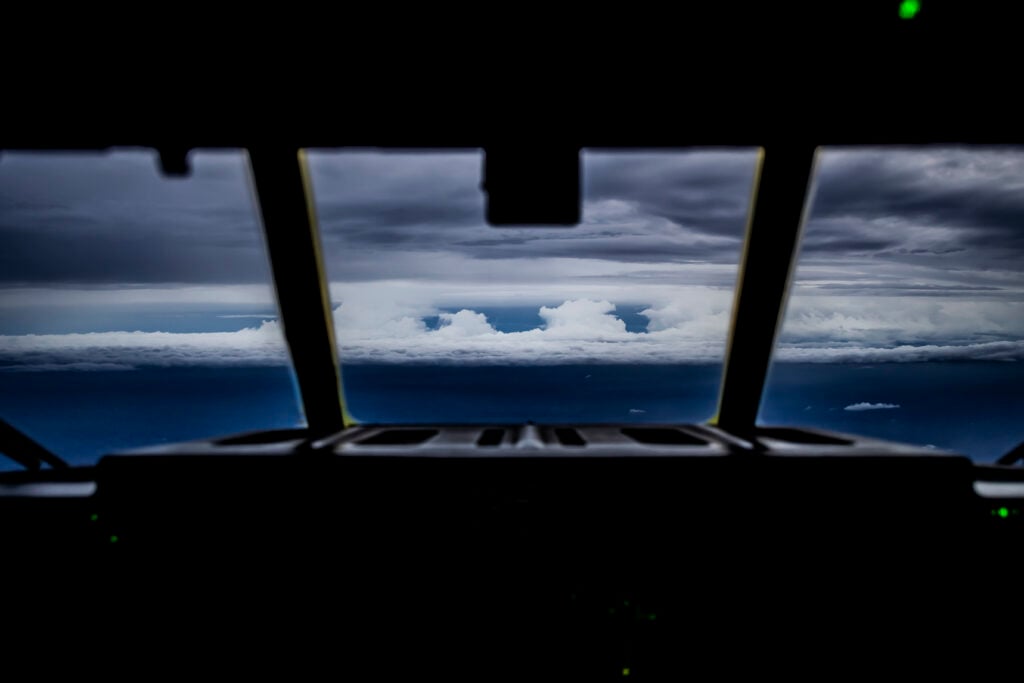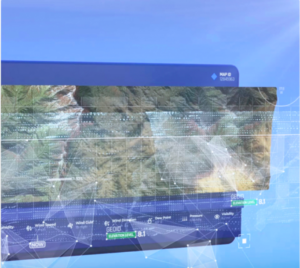
A US HC-C130J approaches the edge of hurricane Florence in 2018.
WASHINGTON: Weather is a major, if easy to overlook, factor in US military planning — one that is becoming even more critical as climate change threatens operations in many areas of the world. But accurate, timely and — perhaps most importantly — hyper-localized information about weather conditions outside of the US and Europe can be surprisingly difficult to obtain.
Enter Tomorrow.io, a Boston-based startup founded by two former Israeli Defense Forces military aviators and a fellow Israeli special operator. The company is using big data analytics to provide military, government and commercial customers with what it calls “weather intelligence.”
It’s an idea that has attracted large enterprise customers such as Delta, JetBlue, Uber and others, but which has also hooked government agencies including the National Oceanic and Atmospheric Administration (NOAA) and NASA. In the Pentagon, it has agreements with both the United States Navy and Air Force; the latter has Tomorrow.io operating under a Small Business Innovation Research (SBIR) contract.
“We don’t think of ourselves necessarily as a weather company in the traditional sense,” said Thomas Cavett, head of business operations for space and a former Green Beret himself. “We call ourselves a ‘weather intelligence’ company. And our goal is really to build the largest vertically integrated weather enterprise, serving all industries, governments etc., and our mission is about helping those entities — governments, businesses, individuals, defense units — to manage all of their different environmental challenges, and make decisions about those challenges.”
In an exclusive interview, Breaking Defense talked with Cavett alongside Dan Stillman, the company’s director of marketing for space and government, and a meteorologist who co-founded the Washington Post’s Capital Weather Gang.
The two explained that the company’s products are designed not just to give a user a forecast about an area of interest, but to provide detailed, actionable information tailored to the users needs via software and AI algorithms designed for each — essentially bespoke weather data for each customer.
“When you hear the term ‘weather intelligence,’ it’s maybe not super clear what that means,” Cavett said. “Weather forecasts [say] ‘there’s a probability of rain.’ What do I do with that? Do I wear a poncho or not? … Weather intelligence will say: if you’re a pilot, you need to avoid these specific flight zones for this geographic area in this specific time window, because it’s going to exceed the limitations of the platform that you’re flying or the payload that you need to deploy.”
There are two keys to being able to do this: gathering the weather data itself; and software designed by working with the client directly to figure out how best to meet their needs, Cavett said.
“We’re first and foremost a software company (including an API), so we created the world’s only proprietary ‘Weather Intelligence Platform’, which includes a dashboard showing insights based on different geographies, routes you might be planning, objective areas you care about,” he explained. “And it tells you what weather events you’re going to care about over the next few days, and what you should do about it in advance.”
Military Applications
Founded in 2015 under the name ClimaCell, the company first concentrated on vacuuming up non-traditional sources of weather data such as atmospheric sensors in cars and cell tower signals, which actually degrade slightly in the rain. It became Tomorrow.io (for The Tomorrow Companies Inc.) only in March, when it racked up some $77 million in Series D investment, and announced its next big step: developing its own constellation of weather radar satellites.
The company intends to launch its first satellite at the end of 2022, with plans to scale up the globe-spanning constellation beginning over the course of 2023 and 2024 to a total of about 32 satellites.
A big part of why the company needs its own constellation is due to military customer requirements, Stillman said, noting “The issue is this data coverage gap exists in areas that we operate on a regular basis in the military.”
Ground-based radars for weather are practically non-existent in Africa, parts of Asia and Latin America, the two execs explained. US civil weather satellite constellations — operated by NOAA, and in the case of rain- and snow-fall monitoring, NASA — also have limited coverage. They further have also been challenged in the recent past due to delays in replacing aging systems.

A look at data from Tomorrow.io
DoD, meanwhile, is still struggling to replace the ancient Defense Meteorological Satellite Program (DMSP) polar orbiting constellation, first launched in the 1960s, after the collapse of the ill-fated (and exorbitant) National Polar-orbiting Operational Environmental Satellite System (NPOESS) in 2010.
The Space Force is now working on two new military satellite systems designed to replace the most critical capabilities of DMSP, according to a May report by Space News. But the new satellites won’t begin operations until 2024 and 2026, which is barely under the wire of the expected DMSP lifespan.
At the same time, DoD’s demand for up-to-the-minute weather information is expanding. Climate change already is affecting operations in many parts of the world, and in January President Joe Biden ordered the department to prioritize it as a national security threat. In April, DoD announced that its new Climate Action Team is reviewing some 5,000 installations around the world to figure out how to mitigate climate-induced risks.
Further, the Air Force has been exploring alternate solutions for rapidly acquiring weather data, including buying weather information as a “service” from commercial providers. Indeed, Tomorrow.io since 2019 has received over $1.8 million in multiple SBIR contracts from the Air Force and NASA, specifically targeted at the needs of Air Force Special Operations Command (AFSOC), and supporting weather information for drone operations, according to the US government’s SBIR website.
“The objective of this proposed R&D program is to adapt and enhance the ClimaCell commercial high-resolution microweather end-user software product functionality, weather data visualization features and proprietary weather sensing and modeling to meet the particular needs of the Air Force weather community. This R&D effort will require the identification and training of a diverse group of USAF weather end-users to test and evaluate the current browser-based and mobile application versions of the ClimaCell HyperCast Aviation weather dashboard and alert system,” the Air Force SBIR award from 2019 states.
Under the ongoing SBIR Phase II contract, the website says, Tomorrow.io “will conduct the software development and quality assurance work to deliver a production version of the software that is accepted by the AF weather community” by Aug. 2, 2021.
Neither the Air Force public affairs office or AFSOC responded to requests for comment.
Iran says it shot down Israel’s attack. Here’s what air defense systems it might have used.
Tehran has been increasingly public about its air defense capabilities, including showing off models of systems at a recent international defense expo.


























